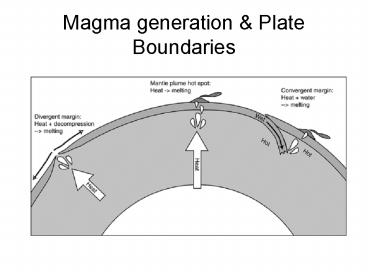Magma generation PowerPoint PPT Presentation
1 / 30
Title: Magma generation
1
Magma generation Plate Boundaries
2
(No Transcript)
3
What explains the location of 95 of the worlds
volcanoes?
4
Volcanism
- Magma Liquid rock underground
- Lava Liquid rock on the surface of the Earth
- Vent Opening in a volcano where lava erupts
- Magma chamber Large store of magma
5
If the asthenosphere is a solid how is magma
(liquid) generated at each place?
- Divergent plate boundary
- Convergent subduction plate boundary-
- Hot spots (not at plate boundary)-
6
Hot Spots
- Hot spots in the mantle can cause melting of the
crust within a tectonic plate. - Hot spots remain stationary in the mantle, but
the lithospheric plate moves across it. - The volcano on the surface is eventually carried
away from the hot spot and becomes inactive. - A new volcano then forms where new crust has
moved over the hot spot.
7
Mafic Hawaiian Islands and Emperor Seamounts
- Hotspot under moving oceanic crust
8
Felsic Yellowstone Hot Spot
9
Magma types
10
Magma Types
11
Mafic Shield volcanoes
- On ocean floor or oceanic islands
- Made from mafic lava
- Because gases can easily escape from mafic lava,
eruptions are relatively quiet. - Form broad, gently sloping shield volcanoes
- Built from many lava flows
- Ex Mauna Loa
12
Mafic Pahoehoe lava flow
13
Mafic Aa Lava Flow
14
Mafic Lava Tubes
15
Mafic Pillow Lava
- Ocean floor near mid-ocean ridges
- pillow lava video
16
Intermediate Composite Volcanoes /
Stratovolcanoes
- In a quiet eruption, lava flows build up cone
- In an explosive eruption, large amounts of
pyroclastic material are deposited on the cone - The resulting cone is formed of alternating
layers of hardened lava flows and pyroclastic
material - Largest explosions destroy part of volcano
- Often tall
- Moderately steep due to stickier lava and
pyroclastic material - Ex.-Mount St. Helens, Mt. Fuji, Mt. Hood, Mt.
Rainier
17
Intermediate Mount St. Helens before 1980
eruption
18
Intermediate Mt. St. Helens following the 1980
eruption
19
Intermediate Mt. Rainier today
20
Intermediate/Felsic Pyroclastic flows
- Pyroclastic material flows downhill after an
eruption - Common on stratovolcanoes
21
Intermediate/Felsic Lahars
- Pyroclastic material mixes with water to form a
mudflow - Common on tall stratovolcanoes that have deep
snowpack or glaciers
22
Lahar hazard in Seattle
23
Cinder Cones
- Made from any magma type
- Caused by small explosive eruptions
- Made from solid fragments ejected from the
volcano - Very steep slopes
- Very small, only a few hundred meters high
24
Size comparison of the three types of volcanoes
25
Cinder cone with crater
- Ex Parícutin, Mexico
26
Intermediate/Felsic Calderas
- When the magma chamber below a volcano is
emptied, the ground collapses - This leaves a large basin-shaped depression
called a caldera
27
Felsic Long Valley Caldera, Mammoth, CA
28
Predicting Volcanic Eruptions
- Use seismographs to monitor small earthquakes
- Indicates growing pressure on the surrounding
rocks as magma works its way upward - Use surveying with lasers and GPS to detect a
slight bulging of the surface of a volcano - Changes in the gases given off by a volcano
- Knowledge of previous eruptions
29
Igneous Intrusions
- Batholith largest, at least 100 km2, means deep
rock, form the cores of many major mountain
chains. - Sills sheet of magma flows between the layers of
rock and hardens parallel to the rock layers - Dikes magma goes through vertical fractures and
hardens, cut across rock layers
30
- Igneous Extrusions - Igneous rock masses that
form on the surface - Volcanic necks - are formed when the vent of an
extinct volcano solidifies and the flanks are
eroded away - Lava Plateaus - develop from lava that flows out
of long cracks in the earths surface. The lava
then spreads over a vast area, filling in valleys
and covering hills.

